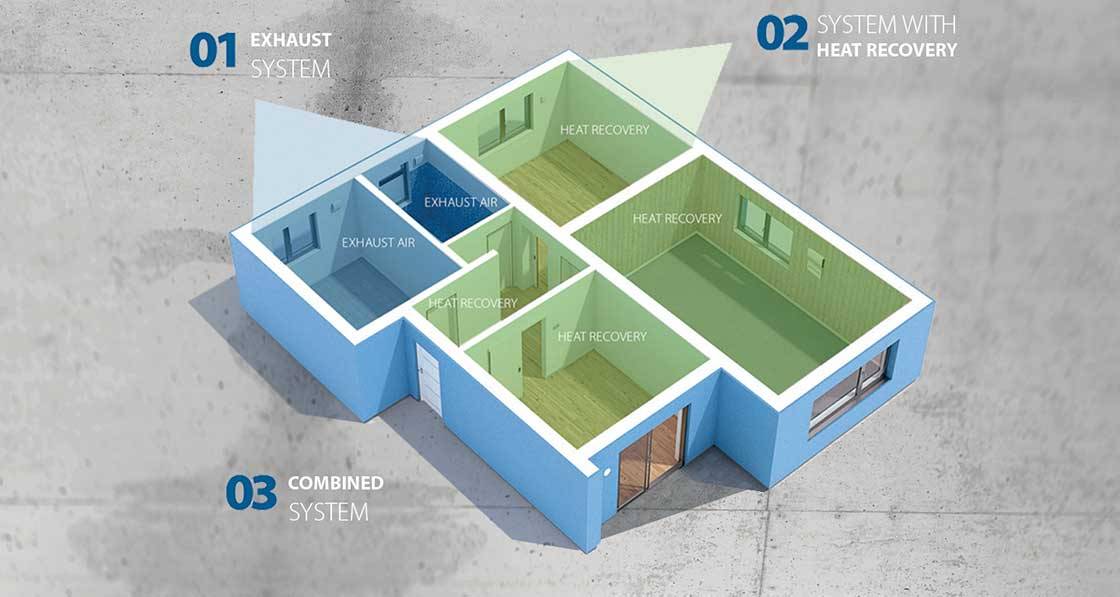
- Marketplace
- Posted
Efficient ventilation key to healthier indoor spaces – Partel
This article was originally published in issue 39 of Passive House Plus magazine. Want immediate access to all back issues and exclusive extra content? Click here to subscribe for as little as €10, or click here to receive the next issue free of charge
During the pandemic, the World Health Organisation has recommended a ventilation rate of 10 litres per second per person in both residential and non-residential settings, or 60 litres (or six air changes) in healthcare facilities. For a new dwelling in Ireland, the building regulations typically require 0.3 litres per second, per square metre of floor area.
“We’re gratified to have been able to play our part in educating and informing business owners and homeowners about the critical role of adequate ventilation,” said Hugh Whiriskey, founder and technical director at Partel. “Ventilation not only enhances human health and comfort by improving indoor air quality and reducing the impact of airborne viruses, but it also controls humidity and protects the structural integrity of buildings.”
There has been particular focus on improving ventilation in schools to prevent the spread of Covid-19, with CO2 monitors being supplied to schools across the country so that teachers can monitor indoor air quality (IAQ). While welcoming this move, Partel technical consultant Dara McGowan says that there may be more fruitful measures for improving classroom ventilation than those suggested by the Department of Education.
“They suggest keeping windows and doors partially open during class, and fully open when the classroom is not in use to encourage natural ventilation. In my opinion, this approach to ventilation is not an appropriate long-term solution for two main reasons: first, it is too crude to provide adequate ventilation for indoor air quality while minimising energy demand, and second, it will cause discomfort for students.”
He continued: “A continuous mechanical extract (CMEV) system, or a mechanical ventilation system with heat recovery capabilities (MVHR) is a much more effective way of providing excellent IAQ while maintaining occupant comfort.
Decentralised MVHR is one of the most common ventilation strategies in central Europe and is what makes Partel’s Lunos system somewhat unique in the Irish market. Decentralised ventilation negates the need for a large central ventilation unit, instead using smaller individual units which are installed in the wall of each room.
“Lunos Nexxt units are constantly supplying fresh air and extracting stale air, increasing the air change rate in the room. These units have been specifically designed for large spaces, such as classrooms, and are capable of up to 30 litres per unit, meaning three units would provide enough fresh air for approximately 30 students. And unlike the purge ventilation techniques being utilised by schools across Ireland currently, the Lunos system can maintain a comfortable temperature in classrooms.”
Partel’s technical design specialists can calculate an appropriate ventilation rate for any type of project. This service is often available free of charge as part of the company’s technical support.
McGowan added that perhaps the biggest advantage of decentralised MVHR in a school setting is the simplicity of retrofitting compared to a centralised system. For more information visit www.partel.ie.
Related items
-
 New Ejot profile cuts thermal bridging losses by 25mm insulation equivalent
New Ejot profile cuts thermal bridging losses by 25mm insulation equivalent -
 Build Homes Better updates Isoquick certification to tackle brick support challenge
Build Homes Better updates Isoquick certification to tackle brick support challenge -
 Ecological Building Systems expands UK and Irish straw panel construction with EcoCocon deal
Ecological Building Systems expands UK and Irish straw panel construction with EcoCocon deal -
 Focus on better buildings, not better spreadsheets
Focus on better buildings, not better spreadsheets -
 MBC offers total passive house envelope solutions
MBC offers total passive house envelope solutions -
 Grant’s Aerona R290: A next-gen heat pump designed for the Irish climate
Grant’s Aerona R290: A next-gen heat pump designed for the Irish climate

